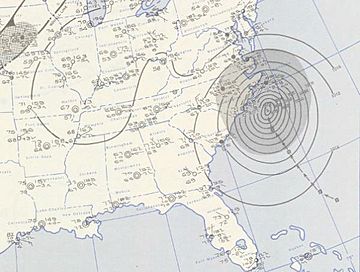Hurricane Ione facts for kids
| Category 4 major hurricane (SSHWS/NWS) | |

September 19, 1955, weather map, featuring Ione
|
|
| Formed | September 10, 1955 |
|---|---|
| Dissipated | September 21, 1955 |
| Highest winds | 1-minute sustained: 140 mph (220 km/h) |
| Lowest pressure | 938 mbar (hPa); 27.7 inHg |
| Fatalities | 7 direct |
| Damage | $88 million (1955 USD) |
| Areas affected | Leeward Islands, North Carolina, Virginia, Newfoundland |
| Part of the 1955 Atlantic hurricane season | |
Hurricane Ione was a very powerful storm, a Category 4 hurricane, that hit the coast of North Carolina in September 1955. It brought really strong winds and a lot of rain. Ione was the third big hurricane to affect the area that year, coming right after Hurricanes Connie and Diane. This meant that many places were already dealing with damage and flooding, and Ione made things even worse.
About Hurricane Ione
Hurricane Ione was a major storm that formed in the Atlantic Ocean. It was one of the strongest hurricanes of the 1955 season. The storm caused significant damage and had a lasting impact on the areas it hit.
Ione's Journey
Ione started as a tropical storm on September 10, 1955. It formed near the Cape Verde islands, off the coast of Africa. As it moved west across the Atlantic, it grew stronger. By September 15, it had become a powerful hurricane.
The storm then turned northwest, heading towards the United States. It reached its strongest point as a Category 4 hurricane. This means its winds were incredibly fast, reaching about 120 miles per hour (195 km/h).
What Happened?
Hurricane Ione made landfall in North Carolina on September 19. It brought heavy rain and strong winds to coastal areas. The storm then moved inland, slowly weakening as it went. It eventually moved back over the Atlantic Ocean and headed towards Newfoundland, Canada, before finally fading away on September 21.
Impact and Damage
The hurricane caused a lot of damage, especially in North Carolina. Homes were flooded, trees were knocked down, and power lines were broken. The total damage from Hurricane Ione was estimated to be around $88 million. Sadly, seven people lost their lives because of the storm.
Because of the severe impact it had, the name "Ione" was later retired. This means no future Atlantic hurricanes will be named Ione. This is done for very destructive or deadly storms to remember their impact.
Images for kids


